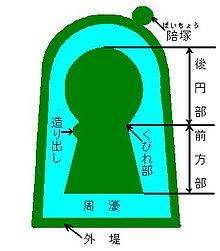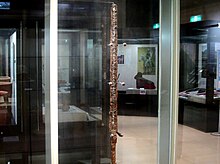Inariyama-Kofun
Inariyama-Kofun ( Japanese 稲 荷 山 古墳 Inariyama kofun ) is a keyhole-shaped barrow ( 前方 後 円 墳zempō kōenfun ) and thus an archaeological site from the late Kofun period in the Japanese community of Gyōda , Saitama prefecture . Sometimes it is also referred to as Sakitama-Inariyama-Kofun to avoid confusion with other barrows of the same name or to clearly identify it among the other kofun found in Saitama . The Inariyama sword was found in the Kofun in 1968 , with 115 golden characters inlaid on both sides of the blade. The sword was declared a national treasure in 1983 . The barrow belongs to the Sakitama Kofu group and has been declared a national historical site. It dates from the second half of the 5th century.
Excavation history
In 1937, earth from the rectangular part of the Kofun was used to build a polder for the purpose of reclaiming land, which damaged the barrow. In 1968 the funeral complex was excavated, in 1973 the outer ditch was opened up, and in 1976 the inner ditch around the Kofun was partially restored. In 2003 an almost complete restoration took place .
overview
With a length of 120 m, the Inariyama-Kofun is the second largest barrow in the prefecture after the Futagoyama-Kofun. The width of the rectangular part is 74 m, the height 10.7 m. The round part has a width of 62 m and a height of 10.7 m. The shape of the Inariyama-Kofun has many similarities with the Daisenryō-Kofun ( 大仙 陵 古墳 ) in Sakai in Osaka Prefecture . According to the Imperial Court Office , in Osaka it is the tomb of Emperor Nintoku ( 百舌 鳥 耳 原 中 陵 Mozu no mimihara no naka no misasagi ). If you reduce the size of the imperial tomb in Osaka by a quarter, it is very similar to the shape of the Inariyama kofun. Since the other two of the nine barrows of the Sakitama-Kofu group in Gyōda, the Futagoyama-Kofun ( 二 子 山 古墳 ) and the Teppōyama-Kofun ( 鉄 砲 山 古墳 ) differ in size from the Inariyama-Kofun, it is assumed that that the Inariyama kofun served as a model for the imperial tomb in Osaka. The two barrows Ōtsukayama-Kofun ( 大 塚 山 古墳 ) in Nara prefecture and the Ryōgūzan-Kofun ( 両 宮 山 古墳 ) in Okayama prefecture have similarities with the imperial tomb in Osaka, although they are smaller .
The Inariyama-Kofun has a protrusion on the western flank of the rectangular porch, called tsukuridashi ( 造 (り) 出 (し) , see illustration). The main axis of the Kofun is aligned in the direction of Fuji-san . The Kofun has been laid out in two stages without stone paving. The round part is surrounded by an inner and an outer trench, which was about 1.8 m deep at the time of construction. On the dome of the round part there is a funeral complex that has been reconstructed. Investigations with a ground penetrating radar in 2016 showed that there are other unexcavated chambers in the burial mound.
Burial and person buried
The funeral complex contains a wooden coffin that was surrounded by a clay wrap ( 粘土 槨nendo-kaku ) and an additional layer of gravel ( 礫 槨 reki-kaku ). Due to the rich grave goods for the buried person, the research considers it very likely that the buried person is a high-ranking person who was related to the Yamamto court ( ヤ マ ト 王 権 Yamato-ōken ), the first state-like entity in Japan. There are essentially three theories about the origin of this person named "Wowake" ( ヲ ワ ケ ):
- Wowake is a head of the Yamato court in the Kinai region , who was awarded the sword that was attached under the gravel layer. Accordingly, it could have been a prince and ancestor of the Abe or Kashiwade clan.
- He is a senior member of the Yamato court posted to the eastern areas.
- It is a person from the eastern areas who was connected to the Yamato court.
So far, however, there is no empirical basis for any of the three explanations.
All three theories bring the text of the Inariyama sword found together with the buried subject to bear. The inscription shows that Wowake was a "leader of the swordtail" who served the great kings. According to the list of ancestors, Wowake served in the 8th generation for the great kings and had reached the peak of reputation.
The first and second theory also relate to the Nihonshoki . There it is reported that in 534 the Ankan - Tennō entrusted the Kasahara family ( 笠原 使 主 Kasahara no omi , onushi for short) with the hereditary administration ( 国 造 kuni no miyatsuko ) of the Musashi province . This theory gained relevance when a medium-sized keyhole-shaped kofun was found in the Kanai region, which shows that Kasahiyo, the name of the father of Wowake engraved on the Inariyama sword, can also be read Kasahara.
Artifacts
Among the excavated artifacts were anthropomorphic haniwa , including figures wearing helmets with ornamental attachments ( 眉 庇 付 冑 mabisashitsuki kabuto ). There is also a haniwa in the form of a maiko with bronze mirrors decorated with bells. In addition, along with the Inariyama sword, other artifacts were declared a national treasure, including bronze mirrors, a comma-shaped jade bead , a gold bronze belt fitting , a silver coin, arrowheads and plates of lamellar armor . It also included horse harness, knives, other swords and tools.
Web links
- 稲 荷 山 古墳 . Museum of Sakitama Ancient Burial Mounds,accessed November 10, 2019(Japanese).
- 埼 玉 古墳 群 . Museum of Sakitama Ancient Burial Mounds,accessed on November 10, 2019(Japanese, map of all nine barrows belonging to the Kofu group).
- 稲 荷 山 古墳 . In:百科 事 典 マ イ ペ デ ィ ア at kotobank.jp. Retrieved November 11, 2019(Japanese).
Individual evidence
- ↑ a b c Detail page on the Inariyama-Kofun Museum of Sakitama Ancient Burial Mounds (Japanese), accessed on November 11, 2019.
- ↑ 保 渡 田 古墳 群 . In: 国 指定 文化 財 等 デ ー タ ベ ー ス . Cultural Affairs Office , accessed November 10, 2019 (Japanese).
- ↑ Detail page on the Futagoyama-Kofun Museum of Sakitama Ancient Burial Mounds (Japanese), accessed on November 11, 2019.
- ↑ 武 蔵 埼 玉 稲 荷 山 古墳 出土 品 . Gyoda City, November 2, 2015, accessed November 11, 2019 (Japanese).
- ↑ List of all barrows of the Sakitama Kofu group Museum of Sakitama Ancient Burial Mounds (Japanese), accessed on November 11, 2019.
- ↑ Detail page on the Teppōyama-Kofun Museum of Sakitama Ancient Burial Mounds (Japanese), accessed on November 11, 2019.
- ↑ ヲ ワ ケ . In: 世界 大 百科 事 典 at kotobank.jp. Retrieved November 11, 2019 (Japanese).
- ↑ Illustration of the artifacts declared as national treasure in the Museum of Sakitama Ancient Burial Mounds (Japanese), accessed on November 11, 2019, with detailed explanations.
Coordinates: 36 ° 7 ′ 45.8 ″ N , 139 ° 28 ′ 51.7 ″ E





